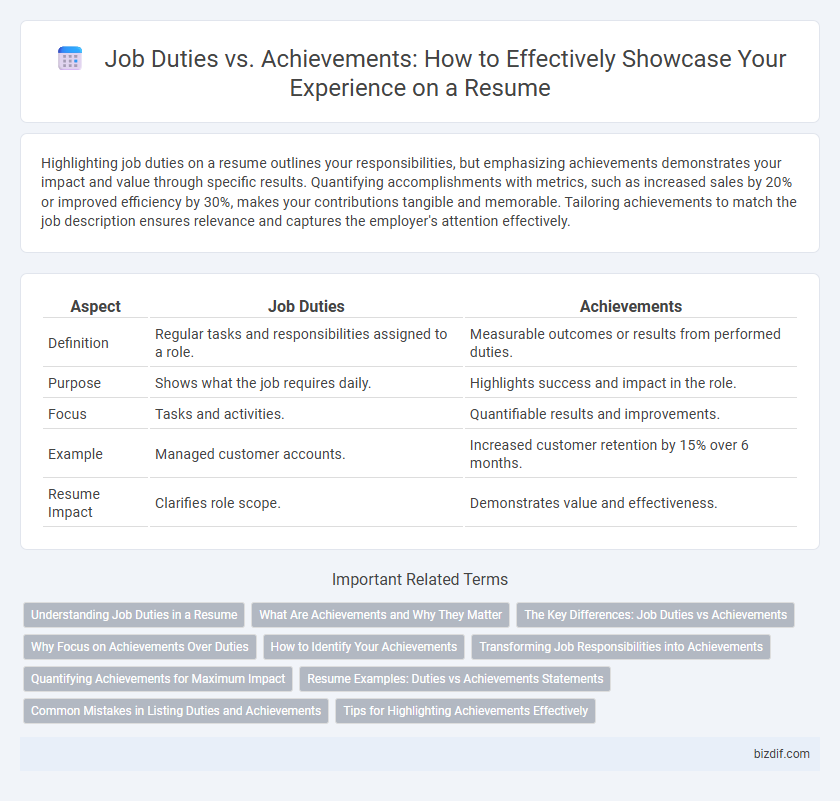Highlighting job duties on a resume outlines your responsibilities, but emphasizing achievements demonstrates your impact and value through specific results. Quantifying accomplishments with metrics, such as increased sales by 20% or improved efficiency by 30%, makes your contributions tangible and memorable. Tailoring achievements to match the job description ensures relevance and captures the employer's attention effectively.
Table of Comparison
| Aspect | Job Duties | Achievements |
|---|---|---|
| Definition | Regular tasks and responsibilities assigned to a role. | Measurable outcomes or results from performed duties. |
| Purpose | Shows what the job requires daily. | Highlights success and impact in the role. |
| Focus | Tasks and activities. | Quantifiable results and improvements. |
| Example | Managed customer accounts. | Increased customer retention by 15% over 6 months. |
| Resume Impact | Clarifies role scope. | Demonstrates value and effectiveness. |
Understanding Job Duties in a Resume
Understanding job duties in a resume is essential for accurately reflecting professional experience and aligning qualifications with job descriptions. Clearly outlining responsibilities emphasizes role-specific skills and industry relevance, helping recruiters assess candidate suitability quickly. Effective presentation of job duties can also serve as a foundation for quantifying achievements and demonstrating impact within previous positions.
What Are Achievements and Why They Matter
Achievements in a resume represent specific accomplishments that demonstrate measurable results and impact, setting candidates apart from others who only list job duties. Highlighting achievements provides concrete evidence of skills and effectiveness, showcasing how a candidate contributed to business goals or solved problems. Recruiters prioritize achievements because they reflect a candidate's value and potential for success in future roles.
The Key Differences: Job Duties vs Achievements
Job duties describe the regular tasks and responsibilities a person is expected to perform in a role, focusing on what the job entails. Achievements highlight specific accomplishments and measurable results that demonstrate the impact made beyond routine duties. Emphasizing achievements in a resume showcases value added to previous employers and distinguishes candidates from others listing generic job duties.
Why Focus on Achievements Over Duties
Highlighting achievements over job duties in a resume demonstrates measurable impact, showcasing your ability to deliver results rather than just performing tasks. Employers prioritize candidates who can prove how they contributed to business growth, efficiency, or problem-solving through specific accomplishments. Emphasizing achievements differentiates your resume by providing quantifiable evidence of your skills and value.
How to Identify Your Achievements
Identify your achievements by quantifying results and highlighting specific contributions that exceed routine job duties. Analyze tasks where you improved processes, saved costs, increased revenue, or received recognition to distinguish achievements from standard responsibilities. Use metrics and clear examples to demonstrate the impact of your work on the organization's success.
Transforming Job Responsibilities into Achievements
Transforming job responsibilities into achievements emphasizes measurable impact and specific contributions, enhancing resume effectiveness. Quantifying results with metrics like increased sales, improved efficiency, or successful project completions demonstrates value to potential employers. Highlighting accomplishments over routine tasks shifts focus to tangible outcomes that differentiate candidates in competitive job markets.
Quantifying Achievements for Maximum Impact
Quantifying achievements in a resume elevates the impact by demonstrating tangible results such as increasing sales by 30% or reducing processing time by 25%. Highlighting specific metrics and outcomes shows employers the value brought to previous roles beyond mere job duties. This data-driven approach differentiates candidates by clearly illustrating their contributions and effectiveness.
Resume Examples: Duties vs Achievements Statements
Job duties in a resume describe routine tasks performed, such as managing schedules or processing reports, while achievement statements highlight measurable accomplishments like increasing sales by 20% or reducing processing time by 30%. Effective resumes prioritize achievements using quantifiable results to demonstrate impact, supported by concise duty descriptions for context. For example, a duty statement might read "Handled customer inquiries," whereas an achievement-focused statement would say "Resolved 95% of customer inquiries within 24 hours, improving satisfaction scores by 15%."
Common Mistakes in Listing Duties and Achievements
Common mistakes in listing job duties and achievements on a resume include confusing routine responsibilities with impactful accomplishments, leading to a lack of distinction. Failing to quantify achievements or using vague language diminishes the demonstrated value to employers. Emphasizing action-oriented results and measurable outcomes enhances clarity and effectiveness in showcasing professional success.
Tips for Highlighting Achievements Effectively
Emphasize quantifiable achievements by using specific metrics, such as percentage increases in sales or project completion times, to demonstrate impact. Use action verbs and concise language to clearly showcase contributions and results rather than listing routine job duties. Tailor achievements to align with the desired role's requirements, highlighting skills and successes most relevant to the employer.
Job Duties vs Achievements Infographic

 bizdif.com
bizdif.com